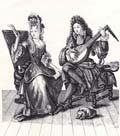By Douglas Lay
 Sometimes a musical instrument may exhibit seemingly inexplicable changes. The tone or playing qualities may vary: a buzz may develop and then disappear, joints may come unglued and cracks may suddenly develop. Any of these things may happen without any mistreatment or abuse of the instrument, as if controlled by unseen forces. What are these forces and how can we deal with them? To help answer these questions, it would be helpful to have a more thorough understanding of the materials and construction principles used in instrument making.
Sometimes a musical instrument may exhibit seemingly inexplicable changes. The tone or playing qualities may vary: a buzz may develop and then disappear, joints may come unglued and cracks may suddenly develop. Any of these things may happen without any mistreatment or abuse of the instrument, as if controlled by unseen forces. What are these forces and how can we deal with them? To help answer these questions, it would be helpful to have a more thorough understanding of the materials and construction principles used in instrument making.
The Material
Fine instruments are constructed of carefully selected pieces of wood. The belly is usually of spruce and the back, sides and scroll are usually of maple, though poplar, pear and other woods may be used for these parts. The fingerboard is almost always of ebony, but the other fittings (pegs, tailpiece, etc.) may be ebony, rosewood, boxwood or some other decorative wood.
Wood is not a homogeneous substance: that is, the cells which constitute the wood have different shapes, sizes and positions depending on their function in the living tree. Most of these cells are cigar shaped, varying in length from 1/16″ to 5/16″, and are oriented vertically in the tree trunk. This vertical orientation of the long fibers determines the direction of the grain in the usable lumber. Not all wood cells have their long axis oriented vertically, though: some radiate horizontally outward from the center of the tree trunk. Examining the particular structure and pattern of wood cells helps the violin maker determine which species of tree yielded the wood and which pieces of wood are best suited for musical instrument construction.
The substances which compose the wood cells are hydroscopic, which means they absorb moisture from a humid environment and give up moisture in dry conditions. Usually, the wood cells swell as they absorb moisture and shrink as they dry out. Because the long cells are not oriented uniformly in all directions, the amount of shrinking and swelling is also not the same in all directions. Wood is most dimensionally stable along the direction of the grain and most variable across the grain, that is, across the short width of most cells.
Other properties besides dimensional stability, such as stiffness and resilience, are also greatly influenced by grain direction. Most cracks occur along the grain, between the long wood cells.
Construction Principles
A violin is composed of dozens of pieces of wood individually shaped and assembled with deliberately different orientations of the grain. This is done to provide maximum strength and stability, properties that are limited by the lightness of build so necessary for proper acoustical function.
The sidewalls, or ribs, of the instrument must be light and thin enough to permit the vibration of the top and back plates while remaining strong enough to support the tremendous forces exerted by the taut strings. For this reason, they are cut from a straight board with the large surfaces parallel to the grain directions and are then bent to their final shape. This means that the grain direction of the ribs follows the outline of the instrument and is parallel to that of the top and back plates along the widest part of the body. Because the grain directions cross each other at the upper and lower block area, the rates of shrinkage and swelling of these parts conflict, possibly giving rise to the accumulation of stress as the wood responds to climatic changes. This is why the glue joints between the ribs and plates in these regions are more susceptible to seasonal failure. Sometimes, the ribs come loose and bulge out in these areas as the shrinking of the plates in width squeezes them.
It is precisely because of the stress that can build when wooden parts with different rates of expansion and contraction are firmly attached together that they are fastened with a natural glue made from the tissue of animals. This hide glue is also hydroscopic so that in hot, humid weather it may soften enough to permit some movement of the wooden parts as they adjust to weather conditions. On the other extreme, during cool, dry weather the glue becomes brittle and may fracture under stress. This fracturing or opening of a glue joint should be considered a fortuitous event because it will hopefully release enough stress to prevent cracks from developing in the wooden parts themselves. Open glue joints are much easier to repair than such splits and cracks.
Conclusion
The natural substances of which stringed instruments are built are not completely predictable, but traditional construction techniques maximize strength and durability while maintaining the lightness so necessary acoustically and for playing comfort. Happily, musicians as well as violinmakers are not ready to sacrifice the acoustical quality and aesthetic appeal of the traditional wooden construction in favor of a more stable material. As long as this is the case the minor concerns related to maintenance will be a factor in their lives.
Of course, the unpredictable materials are much more dimensionally stable in an atmospherically stable environment. Therefore, one thing that can be done to prevent problems is to keep the environment constant or at least moderate the extreme of change in the climate by the use of humidifiers or dehumidifiers when necessary. When travelling, one should keep the instrument protected in a tightly closed case. Extreme temperature changes should also be guarded against.
Some problems with instruments are not caused by abuse and may even arise despite the best of care. When they do come up, it is wise to have them attended to by people trained and skilled in such matters. It is always prudent, however to call ahead when seeking expert help because changing weather can affect many instruments at the same time, all of which need attention.


